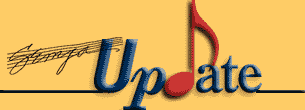
 |
|
I N - T H I S - I S S U E :
|
Phil Ogilvie's Rhythm Kings at the Firefly ClubTo
most of us, the words "big band" bring to mind fifteen or more
musicians sitting in three rows playing a repertoire of dance and jazz
music ranging back to the late thirties. But there were big bands before
the "swing era," and pianist |
|||
| An Ongoing Gig is the first in a new SEMJA UPDATE series meant to review bands that perform regularly in the area. Almost all of our regular reviews deal with out-of-town musicians and this series will try to rectify this bias. |
The rhythm section has become a formidable jazz age
juggernaut centered around Smith's Sousaphone, Rod McDonald's banjo/guitar,
and Steve Fentriss' period traps. The other section of the band that provides a special period feel is the three man sax section of two altos and one tenor, which frequently becomes a clarinet trio, or any sax-clarinet combination. Tom Bogardus can play tenor in the twenties dance band style (e.g., "I Got the World on a String"), which is indeed a rarity today. Mike Jones is a wonderful alto lead and Andrew Bishop is the consummate pro. Bishop must be one of the area's most versatile woodwind players, totally at home in anything from avant garde to Ogilvie's early big band jazz.
Next to the saxes sit the two trumpets and a trombone. Paul Finkbeiner is the main trumpet soloist, and he recreates the beauty of Louis Armstrong numbers like "Savoy Blues" and "West End Blues," and swings mightily, as on "Georgia Swing." The second trumpeter is usually Ingrid Racine, a U-M undergraduate of uncommon talent, now taking a year off abroad. Gene Bartley, Finkbeiner's bandmate in the Paul Keller Orchestra, handles the trombone duties. Like the trumpet players, he has taken to this hot music with joy and dedication, exploring the rich tonal palate characteristic of early brass men, such as those from Duke Ellington's orchestra, who used a variety of mutes, throat growls, and other unorthodox techniques for expressive purposes. But it is mainly Dapogny's arrangements that define the group's sound. Solos are relatively brief, and much of the pleasure for the audience derives from seeing all the different instrumental changes taking place. For most of us these are sounds known only from records, and it is a very different experience to hear them come to life on a Sunday afternoon. Dapogny has transcribed some of the charts from old recordings and adapted rare stock arrangements from the period. The book includes such classics as Ellington's "East St. Louis Toodle-Oo," "Birmingham Breakdown," and "Black and Tan Fantasy," as well as rarely played Jelly Roll big band works such as "Boogaboo." They also play some of King Oliver's big band arrangements (the Dixie Syncopators, not the Creole Jazz Band), like "I Must Have It" and those of Fletcher Henderson, Bennie Moten, and Charles Johnson. You will also hear lesser-known popular music of the time, often with vocals. Tom Bogardus, who does not resemble Marilyn Monroe at all, does a hilarious version of Fud Livingstone's "I'm Through With Love" and tunes like "It Ain't No Sin To Take off Your Skin and Dance Around in Your Bones" feature band vocals. The Firefly Club provides a congenial setting for the band, which has a loyal following. Some have even been known to take the opportunity to shake to the sprightly rhythms on the club's dance floor. photographs by Lars Bjorn |
|||
|
I N - T H I S - I S S U E :
1. CELEBRATING ED LOVE- 2. FORD DETROIT HIGHLIGHTS- - 3. DANILO PEREZ- 4. PHIL OGILVIE 5. MICHIGAN JAZZ FEST- 6. TANI TABAL HOME |